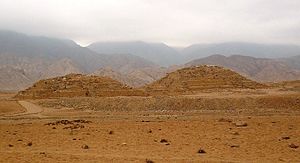Pre-Columbian Americas: Difference between revisions
No edit summary |
No edit summary |
||
| Line 40: | Line 40: | ||
** disrupted fisheries | ** disrupted fisheries | ||
{| border="1" align="right" style="text-align:center; background-color:#E8E8E8; font-size:90%;" cellpadding="5" | |||
|+ | |||
===Predynastic Egypt Timeline=== | |||
!colspan="2" | '''Stone Age to early Civilization''' | |||
|- | |||
| Event | |||
| Date | |||
|- | |||
| Paleolithic Hunter-Gatherers with | |||
semi-nomadic dwellings along Nile | |||
| 30,000- 10,000 BC | |||
|- | |||
| Neolithic period commences along Nile | |||
| 9,000 - 5,500 BC | |||
|- | |||
| boats with sails depicted on rocks | |||
| 6,000 BC | |||
|- | |||
| Egyptian calendar established with the | |||
first recorded date being | |||
| 4241 BC | |||
|- | |||
| trade with Middle East; | |||
linen weaving, household goods; | |||
| 4,000's BC | |||
|- | |||
| Sahara desertification causes | |||
migration to Nile river valley by | |||
| 3,900 BC | |||
|- | |||
| extensive use of copper | |||
| 3,600 BC | |||
|- | |||
| donkey domesticated by | |||
| 3,400 BC | |||
|- | |||
| separate Upper and Lower Egypt | |||
kingdoms solidify | |||
| 3300 BC | |||
|- | |||
| unification of Egypt under Menes | |||
or "Narmer" | |||
| 3100 BC | |||
|- | |||
| Hieroglyphic Writing developed | |||
| 3100 BC | |||
|- | |||
|+ align="bottom" |sources: http://en.wikipedia.org/wiki/Predynastic_Period_of_Egypt | |||
http://en.wikipedia.org/wiki/History_of_ancient_Egypt | |||
http://en.wikipedia.org/wiki/5.9_kiloyear_event | |||
|} | |||
to do | == misc notes / to do === | ||
* Metallurgy in pre-Columbian Americas per region: | * Metallurgy in pre-Columbian Americas per region: | ||
| Line 81: | Line 132: | ||
**** | **** | ||
[[Category:World History]] | [[Category:World History]] | ||
[[Americas]] | |||
Revision as of 15:21, 26 May 2022
See
pre-pottery Andean civilization[edit | edit source]
- west-slope of the Andes
- changes in elevation within close proximity
- provided multiple ecological environments
- variety of
- access to the ocean
- population growth along three river valleys
- Fortaleza, Pativilca, Caral-Supe rivers
Norte Chico civilization, 3500-1800 BC[edit | edit source]
City of Caral[edit | edit source]

- the oldest city in the Americas is "Caral-Supe" or "Caral" in Peru
- "Caral" is the city
- "Supe" = the valley
- built approx. 3,000 BC
- contemporaneous (same time) with Ancient Egypt
- population was approx, 3,000
- other similar sites suggest overall regional population of up to 20,000
- consists of ceremonial, monumental and administrative buildings/ structures
- city layout shows signs of social classes
- large residential complexes near to ceremonial structures
- small rooms in other areas
- built pyramids
- created the pattern of urban design in the Andes through to the Inca
- shows no signs of warfare of defensive structures
Collapse[edit | edit source]
- earthquakes
- wind-blown sand and sediment from wind shift towards inland from the sea
- disrupted agriculture
- disrupted fisheries
| Stone Age to early Civilization | |
|---|---|
| Event | Date |
| Paleolithic Hunter-Gatherers with
semi-nomadic dwellings along Nile |
30,000- 10,000 BC |
| Neolithic period commences along Nile | 9,000 - 5,500 BC |
| boats with sails depicted on rocks | 6,000 BC |
| Egyptian calendar established with the
first recorded date being |
4241 BC |
| trade with Middle East;
linen weaving, household goods; |
4,000's BC |
| Sahara desertification causes
migration to Nile river valley by |
3,900 BC |
| extensive use of copper | 3,600 BC |
| donkey domesticated by | 3,400 BC |
| separate Upper and Lower Egypt
kingdoms solidify |
3300 BC |
| unification of Egypt under Menes
or "Narmer" |
3100 BC |
| Hieroglyphic Writing developed | 3100 BC |
misc notes / to do =[edit | edit source]
- Metallurgy in pre-Columbian Americas per region:
- North America: no smelting
- copper readily available, malleable by hammering
- South America developed smelting
- Mesoamerica metallurgy via South American diffusion
- North America: no smelting
- see: Metallurgy in pre-Columbian America - Wikipedia
- iron readily available
- gold / silver / copper
- gold hammered
- tumbaga: copper-gold alloy
- used for casting
- gems used extensively / jade
- obsidian used for edges/ knives/ cutting
- ability to cut stone
- but not wood
-
- source: The Minerals of Pre-Columbian America | Rock & Gem Magazine (rockngem.com)
-
- Andes region alloy use
- tin used for specific but not general purposes >> "wirework bells"
- tin deposits avail, not exploited
- tin used for specific but not general purposes >> "wirework bells"
- copper smelting in drafted furnaces
- mercury
- platinum developed in Andes region
- copper, gold, silver alloys
- technology adopted by Spanish
- sinnabar
- Andes region alloy use
- wood less useful
- charcoal not developed
- planks not exploited for buildings / ships